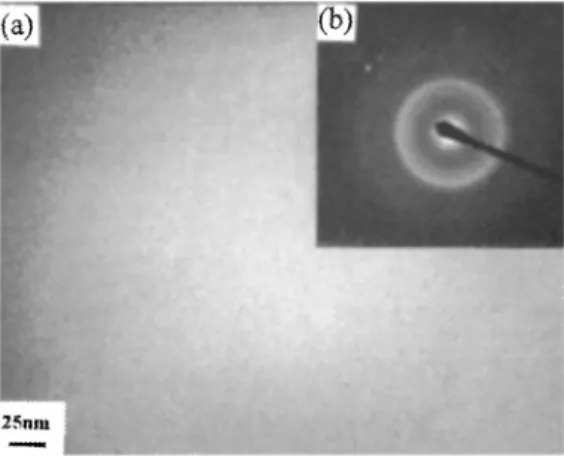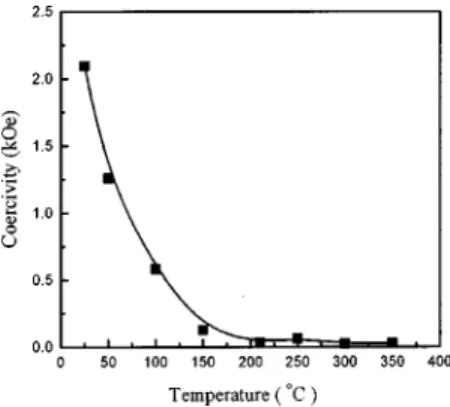Effects of Pt content on the microstructure and magnetic properties
of CoTbPt thin films
P. C. Kuoa)and C. T. Lie
Institute of Materials Science and Engineering, National Taiwan University, Taipei 106, Taiwan S. C. Chen
Department of Mechanical Engineering, De Lin Institute of Technology, Taipei 236, Taiwan C. Y. Chou, T. H. Wu, and L. Y. Chang
Institute of Materials Science and Engineering, National Taiwan University, Taipei 106, Taiwan 共Presented on 14 November 2002兲
This work presents a single-layer CoTbPt film for use as a hybrid-recording medium. Co77.5⫺xTb22.5Ptxfilms with x⫽0 – 14 at. % are fabricated on glass and naturally oxidized silicon wafer substrates by dc magnetron sputtering. The magnetic film is sandwiched between SiNx protective layers to prevent oxidization. The effects of Pt content on the magnetic properties and microstructure of the film are investigated. X-ray diffraction and transmission electron microscope diffraction patterns revealed that all the films are amorphous. It shows that substituting a small amount of Co for the nonmagnetic element Pt will increase the saturation magnetization, the perpendicular remanence, and the perpendicular coercivity of the Co77.5Tb22.5film. It is found that the saturation magnetization of the Co75.3Tb22.5Pt2.2film is about 245 emu/cm
3
, the perpendicular squareness is about 0.8, perpendicular coercivity is about 2100 Oe at room temperature and the coercivity decreases rapidly with increasing temperature. The coercivity is decreased to about 50 Oe when temperature is increased to 200 °C. © 2003 American Institute of Physics.
关DOI: 10.1063/1.1555796兴
I. INTRODUCTION
The hybrid-recording method, which combines ther-mally assisted writing and magnetic flux detection, has been suggested to increase the recording density of magnetic disks.1–3In this method, the small perpendicular domains are formed by thermomagnetic writing and detected by a high-resolution giant magnetoresistive共GMR兲 head or a tunneling magnetoresistive 共TMR兲 head.
The recording media for hybrid recording must satisfy three requirements: 共1兲 they must provide satisfactory magneto-optical writing performance; 共2兲 they must have a large saturation magnetization, Ms, that generates sufficient magnetic flux for the GMR head or the TMR head readout, and共3兲 they must have a large perpendicular coercivity, Hc, to resist self-demagnetization. The traditional magneto-optical共MO兲 recording medium has been considered for use as a hybrid recording medium because of its writing prin-ciple is the same as that of hybrid recording. However, the
Ms value of the MO medium at room temperature is too small to generate sufficient magnetic flux for GMR or TMR head readout. The bilayer structure, including a readout layer and a recording layer, is proposed to solve this problem.4,5 The recording layer has good thermomagnetic writing char-acteristics and a high Hc at room temperature. The readout layer has a large Msat room temperature, and thus generates sufficient flux density for GMR or TMR head sensing.
This study aims to find a single-layer recording medium which is suitable for a hybrid-recording medium application.
Previously, we showed that the magnetic properties of amor-phous CoTb film are sensitive to the composition of the film and the process parameters.6 The perpendicular coercivities of some amorphous CoTb films are very large, but their Ms values are small at room temperature. This work incorporates Pt in the CoTb alloy film to increase its Ms value. The ef-fects of Pt content on the structure and magnetic properties of the CoTbPt film are also investigated.
II. EXPERIMENT
Co77.5⫺xTb22.5Ptx films with x⫽0 – 14 at. %, were de-posited on glass and on naturally oxidized Si共100兲 substrates by dc magnetron sputtering at room temperature. The target was a Co disk overlaid with Tb and Pt pieces to obtain a desired film composition. The base pressure was 5 ⫻10⫺7 Torr and the sputtering pressure of Ar gas was main-tained at 4 mTorr. The magnetic film was sandwiched be-tween SiNx protective layers to prevent oxidization. The SiNxprotective layers were produced by rf magnetron sput-tering of an Si3N4 target. The thicknesses of the Co77.5⫺xTb22.5Ptx layer and the SiNx layer were 75 nm and 30 nm, respectively.
The microstructures of the films were examined by x-ray diffraction 共XRD兲 with Cu K␣ radiation, and by transmis-sion electron microscopy 共TEM兲. Depth profiles of the ele-ments in the films were analyzed by Auger electron spectros-copy 共AES兲. Compositions of the films were determined by x-ray energy dispersive spectroscopy. The magnetic proper-ties of the films were measured using a vibrating sample magnetometer.
a兲Electronic mail: pckuo@ccms.ntu.edu.tw
JOURNAL OF APPLIED PHYSICS VOLUME 93, NUMBER 10 15 MAY 2003
7777
0021-8979/2003/93(10)/7777/3/$20.00 © 2003 American Institute of Physics
III. RESULTS AND DISCUSSION
Figure 1 shows the –2 XRD patterns of various Co77.5⫺xTb22.5Ptx films with different Pt contents. No film presents a diffraction peak. This implies that all Co77.5⫺xTb22.5Ptxfilms are amorphous. Figure 2共a兲 is a typi-cal TEM image of the Co77.5⫺xTb22.5Ptx film, in which x ⫽13.5. The film includes no crystal grains. When the speci-men is examined in detail, a lemon peel-like microstructure is observed.6Figure 2共b兲 is the electron diffraction pattern of the film; the broad diffusive diffraction rings indicate that this film has an amorphous structure.
The rare earth-transition metal共RE-TM兲 magnetic films are easily oxidized. Figure 3 shows the depth profiles of elements in the Co74.5Tb23Pt2.5film. We can see that 30 nm SiNx protective layer is effective to prevent the oxidization of this magnetic film. Some oxygen is present in the two SiNx protective layers and in the surface of the naturally oxidized Si substrate but not in the magnetic layer.
Figure 4共a兲 shows the variations of saturation magneti-zation, Ms, and perpendicular remanence, Mr, with Pt con-tent of the Co77.5⫺xTb22.5Ptx films at room temperature. The
Ms and Mr values of the Co77.5Tb22.5 film (x⫽0 at. %) are about 135 emu/cm3 and 85 emu/cm3, respectively. Ms and
Mrincrease rapidly with Pt content x⬍2.2 at. %. Then, they increase slowly with Pt content when x⬎2.2 at. % Ms ex-ceeds 230 emu/cm3 and Mr exceeds 175 emu/cm3 when x
⬎2 at. %. The variation of the squareness, Mr/ Ms, with Pt content is very small: The squareness of the film exceeds 0.75 when x⬎2 at. %.
CoTb alloy is sperimagnetic.7The magnetization of the Co subnetwork is antiparallel to that of the Tb subnetwork. The compensation temperature, Tcomp, of the RE-TM alloy is very sensitive to the composition of the alloy. Co77.5Tb22.5 is TM rich because its Tcomp is lower than room temperature.8,9The magnetization of the Co77.5Tb22.5alloy is parallel to the direction of Co magnetization. When some Co atoms are substituted for the nonmagnetic Pt atoms, the mag-netization of the Co77.5⫺xTb22.5Ptxalloy system declines. So, the Msof the Co77.5⫺xTb22.5Ptxfilm decreases as the Pt
con-tent, x, is increased. However, the Ms of the
Co77.5⫺xTb22.5Ptxfilm increases with Pt content, as shown in Fig. 4共a兲, owing to the effect of the Co–Pt interface on the FIG. 1.–2XRD patterns of various Co77.5⫺xTb22.5Ptxfilms.
FIG. 2.共a兲 TEM bright-field image and 共b兲 electron diffraction pattern of the Co64Tb22.5Pt13.5film.
FIG. 3. AES depth profiles of the elements in the Co75Tb22.5Pt2.5film.
FIG. 4. 共a兲 Variation of Msand Mrwith Pt content in the Co77.5⫺xTb22.5Ptx
film and共b兲 Msvalues calculated from Eq.共1兲.
7778 J. Appl. Phys., Vol. 93, No. 10, Parts 2 & 3, 15 May 2003 Kuoet al.
magnetization.10–12The magnetization of Co is increased due to the polarization of the Pt atoms. The relationship between
Ms and x of this Co77.5⫺xTb22.5Ptx alloy film can be ex-pressed as
Ms⫽Ms共Co77.5Tb22.5兲⫹␣ln共1⫹xMCo–Pt/ Ms共CoTb兲兲, 共1兲
where Ms(Co77.5Tb22.5) is the saturation magnetization of the Co77.5Tb22.5film (x⫽0) and MCo–Ptis the induced magneti-zation due to the effect of the Co–Pt interface. Ms(CoTb) is
the saturation magnetization of CoTb for the
Co77.5⫺xTb22.5Ptxalloy except Pt.␣is a constant. Figure 4共b兲 plots Eq.共1兲 with the values of the constants chosen to give the best fit to the experimental Ms values in Fig. 4共a兲. The
best fit is obtained with ␣⫽30.5 emu/cm3 and
MCo–Pt/ Ms(CoTb)⫽5.8. Clearly, MCo–Ptcan be determined if
Ms(CoTb)is known.
Figure 5 plots the relationship between perpendicular co-ercivity Hcand the Pt content of the Co77.5⫺xTb22.5Ptxfilm at room temperature. The Hcvalue increases from about 1000 Oe to 2100 Oe as Pt content increases from 0 at. % to 2.2 at. %, and Hcdecreases rapidly as x⬎2.5 at. %. The increase of Hc with Pt content may be owing to that some Pt atoms close together into Pt clusters in the CoTbPt film. These clusters are like defects that cling to the domain wall to re-duce the domain-wall energy,13pinning the movement of the domain wall, and increasing the coercivity of the film.14This pinning effect depends on the thickness of the domain wall and the size of the defects. Maximum pinning effect occurs when the size of the defect is about equal to the thickness of the domain wall.13When the Pt content of the film exceeds 2.5 at. %, the diameter of some Pt clusters may exceed the thickness of the domain wall, reducing the pinning effect. Therefore, the Hcvalue decreases as the Pt content increases as x⬎2.5 at. %.
Figure 6 plots the relationship between the Hcvalue and the temperature of the Co75.3Tb22.5Pt2.2film, showing that the
Hc value decreases rapidly from 2100 Oe to about 50 Oe as the temperature increases from 25 °C to 200 °C. The Ms
value of the Co75.3Tb22.5Pt2.2film is about 245 emu/cm3, the squareness is about 0.8, and the Hcis about 2100 Oe at room temperature. The rapid decrease in Hc with an increase in temperature is shown in Figs. 5 and 6.
IV. CONCLUSION
The effects of Pt content on the microstructure and mag-netic properties of the Co77.5⫺xTb22.5Ptx films with x ⫽0 – 14 at. % were investigated. The XRD and TEM analy-sis indicated that all these films are amorphous. Substituting a small amount of Co for Pt will increases the Ms, Mr, and
Hc of the Co77.5Tb22.5film.
ACKNOWLEDGMENT
This work was supported by the National Science Coun-cil of Taiwan, R.O.C. through Grant Nos. NSC 90-2216-E 002-036 and MOE 91-EC-17-A-08-S1-0006.
1H. Saga, H. Nemoto, H. Sukeda, and M. Takahashi, Jpn. J. Appl. Phys.,
Part 1 38, 1839共1999兲.
2J. J. M. Ruigrok, R. Coehoorn, S. R. Cumpson, and H. W. Kesteren, J.
Appl. Phys. 87, 5398共2000兲.
3
H. Sukeda, H. Saga, H. Nemoto, Y. Itou, C. Haginoya, and T. Matsumoto, IEEE Trans. Magn. 37, 1234共2001兲.
4H. Nemoto, H. Saga, H. Sukeda, and M. Takahashi, Jpn. J. Appl. Phys.,
Part 1 38, 1841共1999兲.
5
C. C. Lin, C. H. Lai, B. M. Chen, and H. P. D. Shieh, IEEE Trans. Magn.
37, 1339共2001兲.
6P. C. Kuo and C. M. Kuo, J. Appl. Phys. 84, 3317共1998兲.
7P. Hansen, Handbook of Magnetic Materials, edited by K. H. J. Buschow 共Elsevier, New York, 1991兲, Vol. 6, Chap. 4, p. 310.
8
M. Mansuripur, The Physical Principles of Magneto-optical Recording
共Cambridge University Press, Cambridge, UK, 1995兲, p. 46.
9P. Hansen, S. Klahn, C. Clausen, G. Much, and K. Witter, J. Appl. Phys.
69, 3194共1991兲.
10
J. A. Mydosh and G. J. Nicuwenhuys, Ferromagnetic Materials, edited by E. P. Wohlfarth共North–Holland, Amsterdam, 1980兲, Vol. 1, p. 71.
11P. F. Carcia, J. Appl. Phys. 63, 5066共1988兲.
12H. Hamouda, H. Lassri, R. Krishnan, and D. Saifaoui, Solid State
Com-mun. 108, 451共1998兲.
13
B. D. Cullity, Introduction to Magnetic Materials共Addison–Wesley, Lon-don, 1972兲, p. 317.
14M. Mansuripur, The Physical Principles of Magneto-optical Recording 共Cambridge University Press, Cambridge, UK, 1995兲, p. 46.
FIG. 5. Variation of Hcwith Pt content of the Co77.5⫺xTb22.5Ptxfilm. FIG. 6. Relationship between Hc and temperature of the Co75Tb22.5Pt2.5
film.
7779
J. Appl. Phys., Vol. 93, No. 10, Parts 2 & 3, 15 May 2003 Kuoet al.

